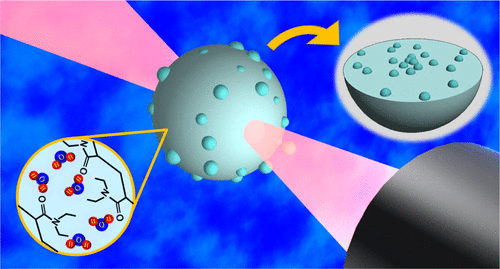
[集光レーザー型光ピンセットによるコアセルベート形成]
集光近赤外レーザー光による光圧と光熱効果によりポリ(N,N-ジエチルアクリルアミド) (PDEA)水溶液中にwater-in-oil-in-water(w/o/w)型のコアセルベート液滴を形成することに成功し、液滴中の高分子構造を顕微ラマン分光法により明らかにしました。
坪井教授(大阪市立大学)、麻生准教授(大阪大学)らのグループとの共同研究の成果です。
- 研究成果のポイント
- 温度応答性高分子のPDEA(Mw = 74,000, Mw/Mn = 1.1)軽水溶液中に波長1064 nmの近赤外レーザー光を集光すると、w/o/wエマルジョン様の単一液滴の形成・光捕捉に成功
- 顕微ラマン分光法により液滴中の高分子濃度をおよそ30 wt%と決定することに成功
- 下限臨界溶液温度(LCST)以上に溶液を加温し形成した液滴を光捕捉すると、拡散律速凝集(DLA)とオストワルド熟成に起因する液滴成長を観測
- Formation of Single Double-Layered Coacervate of Poly(N,N-diethylacrylamide) in Water by a Laser Tweezer
- Mitsuhiro Matsumoto, Taka-Aki Asoh, Tatsuya Shoji, Yasuyuki Tsuboi
- Langmuir, 37 (2021), 2874-2883.
- DOI: 10.1021/acs.langmuir.0c03009
We demonstrate liquid–liquid phase separation involving both coacervation and coil-to-globule phase transition of a thermoresponsive polymer. By focusing a near-infrared laser beam into an aqueous solution of poly(N-isopropylacrylamide) (PNIPAM), a single phase-separated polymer microdroplet can be formed and stably trapped at the focal point. Such droplet formation is induced by a local elevation in temperature (induced by a photothermal effect) and an optical force. The technique allows us to selectively analyze a single polymer droplet trapped at the focal point. In this study, we applied this technique to poly(N,N-diethylacrylamide) (PDEA) in water and generated a double-layered PDEA droplet. Such an inhomogeneous and complex microstructure has not been previously observed both in steady-state heating of a PDEA solution and in the PNIPAM system. Moreover, we used micro-Raman spectroscopy to clarify that PDEA underwent dehydration due to a coil-to-globule phase transition. Despite this, the polymer concentration (Cpoly) of the trapped PDEA droplet was very low and was around 30 wt %. Cpoly depended on the molecular weight of PDEA and the laser power that regulates the temperature elevation. These results strongly indicate that PDEA undergoes coacervation in addition to a coil-to-globule phase transition. This study will help provide us with a fundamental understanding of the phase separation mechanisms of thermoresponsive polymers.
https://pubs.acs.org/doi/abs/10.1021/acs.langmuir.0c03009